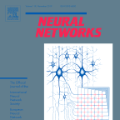We introduce a novel method for showers reconstruction from the data collected with electromagnetic (EM) sampling calorimeters. Such detectors are widely used in High Energy Physics to measure the energy and kinematics of in-going particles. In this work, we consider the case when a large number of particles pass through an Emulsion Cloud Chamber (ECC) brick, generating electromagnetic showers. This situation can be observed with long exposure times or large input particle flux. For example, SHiP experiment is planning to use emulsion detectors for dark matter search and neutrino physics investigation. The expected full flux of SHiP experiment is about $10^{20}$ particles over five years. Because of the high amount of in-going particles, we will observe a lot of overlapping showers. It makes EM showers reconstruction a challenging segmentation problem. Our reconstruction pipeline consists of a Graph Neural Network that predicts an adjacency matrix for the clustering algorithm. To improve Graph Neural Network's performance, we propose a new layer type (EmulsionConv) that takes into account geometrical properties of shower development in ECC brick. For the clustering of overlapping showers, we use a modified hierarchical density-based clustering algorithm. Our method does not use any prior information about the incoming particles and identifies up to 82% of electromagnetic showers in emulsion detectors. The mean energy resolution over $17,715$ showers is 27%. The main test bench for the algorithm for reconstructing electromagnetic showers is going to be SND@LHC.
翻译:我们从电磁(EM)采样卡路里计收集的数据中引入了重建淋浴的新方法。 这些探测器被广泛用于高能物理, 以测量流中粒子的能量和运动力。 在这项工作中, 我们考虑大量粒子通过一个乳胶云室砖块通过, 产生电磁淋浴。 这一情况可以用长期接触时间或大量输入粒子通量来观察。 例如, ShiP 实验计划使用乳胶探测器进行暗物质搜索和中微子物理调查。 ShiP 实验预计将在五年内全部流动约10 20美元。 由于大量流粒子, 我们将观察大量重叠的淋浴。 它使大量粒子通过一个充电云室砖块块块重新形成具有挑战性的分解问题。 我们的重建管道由一个图神经网络组成, 用来预测组合算法的相近距离矩阵。 为了改进图形神经网络的性能, 我们建议一个新的层类型( Emulion Connion), 考虑淋浴的阵列的阵列的阵列的温度特性特性值值值值值值值值值值值为 。 在ECC 内, 的阵列中, 的阵列中, 将整列的阵列的阵列中, 将使用任何的阵列的阵列的阵列的阵列的阵列的阵列的阵列的阵列的阵列的阵列的阵列的阵列的阵列的阵列的阵列, 将使用任何的阵列的阵列的阵列的阵列的阵列的阵列的阵列的阵列的阵列的阵列的阵列的阵列, 。



